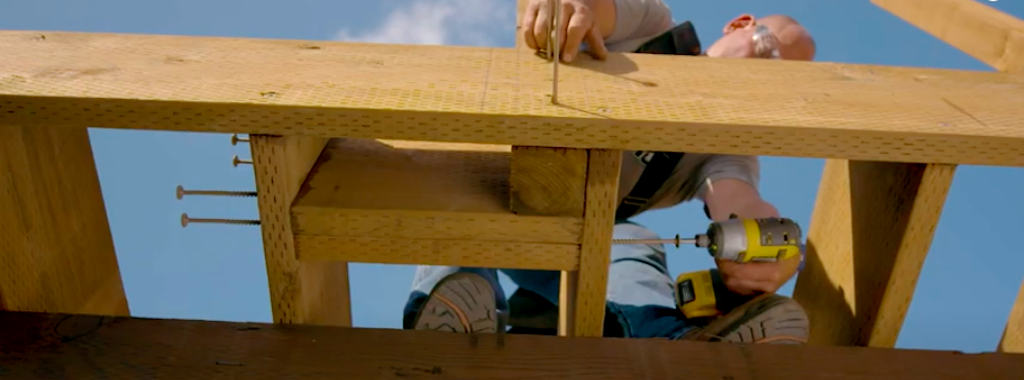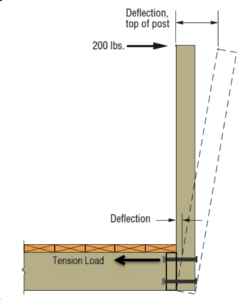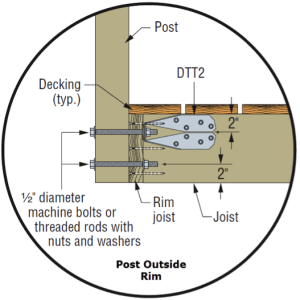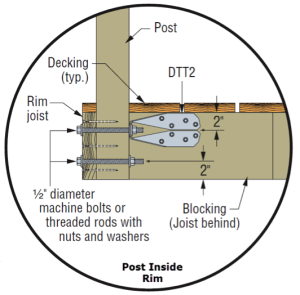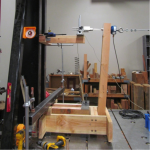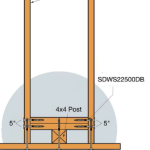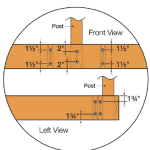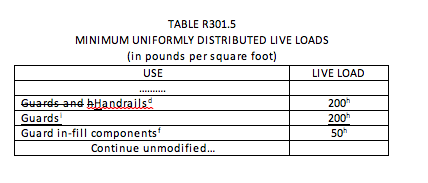In this post, we follow up on our May webinar, Safer, Stronger Decks: Guard Post Connections, by answering some of the interesting questions raised by attendees.
Tag: deck safety
Deck Guardrail Update
This post is an update to David Finkenbinder’s post on Guard Post Resources from August 13.
As David explained, the requirements in the IRC and IBC for guards are intended to prevent people from falling off of raised surfaces. The failure of this guard is a common source of injuries caused by failures of deck components.
Section R312.1.1 of the 2012 International Residential Code (IRC) states that “Guards shall be located along open-sided walking surfaces, including stairs, ramps and landings, that are located more than 30 inches measured vertically to the floor or grade below at any point within 36 inches horizontally to the edge of the open side.”
Table 301.5 of the 2012 IRC requires that guards and handrails be designed for “[a] single concentrated load” of 200 pounds “applied in any direction at any point along the top.”
David mentioned the article Tested Guardrail Post Connections for Residential Decks, which described a testing program at Virginia Tech that examined the ability of various assemblies to resist this concentrated load at the top of the guard post. But rather than test in any direction, the researchers decided to test in what they considered the most critical direction: outward away from the deck.
Simpson Strong-Tie subsequently developed a new tension tie, the DTT2Z, to make an economical connection from the top bolt in a deck post back into the framing of the deck to resist the high tension forces that develop in the top bolt when the top of the post is pushed outward. Several details were developed to try to address the various orientations of the post and deck framing.
To allow evaluation of assemblies used to resist this deck guardrail force, ICC-ES developed AC273, Acceptance Criteria for Handrails and Guards. AC273 is available for purchase through the ICC bookstore.
Even with the connectors being readily available, deck builders have asked for guard post connection details that do not involve the use of connection hardware. So Simpson Strong-Tie again tested several framing configurations according to the AC273 criteria, using our Strong-Drive® SDWS TIMBER screws and additional blocking to try to prevent the post from rotating. These details are shown in the engineering letter L-F-SDWSGRD15.
That brings us to the update part.
A committee made up of building officials, manufacturers, deck builders, designers and other interested parties is currently developing a set of code proposals on deck construction for inclusion in the 2018 International Residential Code (IRC). Even though more and more deck information has been incorporated into the last few editions of the IRC, there is still insufficient information in the code to be able to completely build a deck prescriptively. One area of interest is this guard connection. There is a desire to develop prescriptive details for both connection of a 4×4 post to deck framing with blocking and fasteners and for connecting the deck band joist back to the deck framing so that pre-manufactured guard rails can simply be fastened to the deck band with the knowledge that the connection is secure.
The problem is that, with the current requirement, the guard must resist the 200-pound load in ANY direction. All current testing, including AC273, only uses testing in the outward direction away from the floor of the deck. If the post were really required to resist a 200 pound load in the inward direction as well, then two hardware connectors would be required, one on each bolt. However, the belief of the committee is that resistance of 200 pounds in the outward and downward direction is primarily what is needed to ensure the safety of the occupants of the deck.
So they are working on a code proposal to change Table R301.5 of the IRC to require that the guard only resist the 200 pounds in the outward and downward direction and reduce the load to 50 pounds in the inward and upward direction.
The committee recognizes that while this is not necessarily a departure from current practice, it is a departure from current loading requirements in the IRC, IBC, and ASCE 7. So representatives of Simpson Strong-Tie met on September 30 with the NCSEA Code Advisory Committee – General Requirements Subcommittee to get the opinions of this group of active structural engineers. They provided valuable input, including the consideration that at some locations near landings and other changes in elevation, resistance to 200 pounds in the inward direction could be important.
Prior to incorporation of NCSEA’s input, the committee thought the code change might look as shown below.
We are interested in getting additional comments on this code proposal. What do you think? Let us know in the comments below.
d) A single concentrated load applied in any direction at any point along the top, in pounds.
f) Guard in-fill components (all those except the handrail), balusters and panel fillers shall be designed to withstand a horizontally applied normal load of 50 pounds on an area equal to 1 square foot. This load need not be assumed to act concurrently with any other live load requirement.
h) Glazing used in handrail assemblies and guards shall be designed with a safety factor of 4. The safety factor shall be applied to each of the concentrated loads applied to the top of the rail, and to the load on the in-fill components. These loads shall be determined independent of one another, and loads are assumed not to occur with any other live load.
j) A single concentrated load applied at any point along the top, in pounds. The 200-pound load is required to be applied in either the outward or downward direction, and it is permitted to be reduced to 50 pounds in either the inward or upward direction. The guard is not required to resist these loads applied concurrently with each other.
Wood-framed Deck Design Resources for Engineers
This week’s blog was written by David Finkenbinder, P.E., who is a regional engineer working out of the Simpson Strong-Tie Ohio branch which services 24 states through the Northeast, Midwest, and Mid-Atlantic. He graduated from Penn State with a B.S. in Agricultural and Biological Engineering in 2004 and earned his M.S. in Civil Engineering with a focus on Structural Engineering from Virginia Tech in 2007. His master’s thesis investigated the splitting strength of bolted connections in solid-sawn lumber and structural composite lumber. Since joining Simpson Strong-Tie in 2007, David has shown a passion for deck safety and has served on committees developing prescriptive information and building code provisions for decks. Here is David’s post.
“Decks cause more injuries and loss of life than any other part of the home structure. Except for hurricanes and tornadoes, more injuries may be connected to deck failures than all other wood building components and loading cases combined.”
This quote, taken from Washington State University’s magazine article Making Decks Safer, underscores the critical importance of proper deck design, construction, and maintenance. An engineer who is encountering their first deck may be surprised that the deck design resources available are not as plentiful as he/she might have expected. The following resources can be helpful start:
For decks built to the IRC, the book Deck Construction Based on the 2009 International Residential Code provides a review of applicable code provisions and related commentary. The book gives background on important durability considerations such as flashing at points where the deck connects to an adjacent structure. The book also briefly discusses variations with IBC provisions, which can be significant for examples such as minimum guard height and live loads.
The American Wood Council (AWC) has several tools available in addition to using the NDS for wood member and connection design. Calculators for evaluating simple span joists and single fastener connections are available in both web-based and mobile app format. Technical Report 12, which was the topic of our May blog post, provides the ability to design connections with a gap between members, or with members having a hollow cross section. AWC’s DCA6 – Prescriptive Residential Wood Deck Construction Guide presents information for common deck details and a commentary covering important considerations for alternate designs. While the guide is helpful, please note that it is limited in scope to single level residential decks and does not address wind or seismic design.
Researchers at Virginia Tech and Washington State University conducted laboratory testing and published information to help in several common topics needing attention. An article in the May 2008 issue of Structure Magazine featured test performance of ledger-to-band joist connections using bolts or lag screws – this information has since been adopted into the IRC.
For lateral design there has been some uncertainty regarding lateral loads that can be generated by occupants, and if the magnitude of such is significant in comparison with wind and seismic forces calculated from ASCE 7. Tests were conducted of occupants performing several types of movement on a deck floor configuration. Separate articles summarizing results for each load type were published in the Summer 2013 issue of Wood Design Focus, along with a fourth article on the lateral performance of IRC ledger attachments (online copies of the articles courtesy of Professional Deck Builder magazine: Wind Loads; Seismic Loads; Occupant Loads).
Our January 2013 post, Corrosion: The Issues, Code Requirements, Research, and Solutions, touches on the corrosion considerations that are significant for most projects as well.
Have you found any other resources that have been helpful in your designs? Let us know by posting a comment.
Who’s Thinking About Deck Safety? I Am!
A few months ago, the Today Show asked Simpson Strong-Tie to demonstrate a deck collapse to educate the public about deck safety. Often through the Fall and Winter months, decks go unused yet see a lot of activity from rain, sleet and snow. When the sun comes out in the Spring, people get out on their decks again without much thought about how the elements may have affected the important connections on their deck.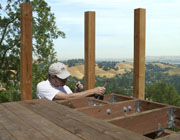
In addition to the weather, there are other factors to consider about deck safety:
- Experts agree that the average life expectancy of a wood deck is 10 to 15 years.
- It’s estimated that there are millions of decks in the U.S. that are beyond their useful life and may be unsafe.
- The number of deck collapses has increased in recent years.
- Within the past five years, 651 injuries and four deaths have occurred due to deck collapse.
So, I’m thinking about deck safety. I thought I’d share with you the “5 Warning Signs of an Unsafe Deck” we discussed on the Today Show:
Who's Thinking About Deck Safety? I Am!
A few months ago, the Today Show asked Simpson Strong-Tie to demonstrate a deck collapse to educate the public about deck safety. Often through the Fall and Winter months, decks go unused yet see a lot of activity from rain, sleet and snow. When the sun comes out in the Spring, people get out on their decks again without much thought about how the elements may have affected the important connections on their deck.
In addition to the weather, there are other factors to consider about deck safety:
- Experts agree that the average life expectancy of a wood deck is 10 to 15 years.
- It’s estimated that there are millions of decks in the U.S. that are beyond their useful life and may be unsafe.
- The number of deck collapses has increased in recent years.
- Within the past five years, 651 injuries and four deaths have occurred due to deck collapse.
So, I’m thinking about deck safety. I thought I’d share with you the “5 Warning Signs of an Unsafe Deck” we discussed on the Today Show:
Continue Reading

